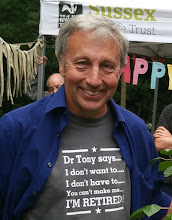
Over 200 people came along to our AGM on Saturday 31st October and were treated to an excellent presentation by Chris Packham.
It would have been great to get him along just to hear about his favourite wildlife observations, and maybe listen to some stories from the Autumnwatch programme. But what we got was an inspiring challenge – recognising what we have done so far but spurring us on to do more.
Before Chris’s talk I gave a rather disorganised ramble through SWT action over the last year – a discussion of the projects we are engaged in. This had a positive slant because, obviously, I am quite proud of what the Trust is doing. He said that while this is great – it is not enough. We have still not turned the tide and reversed the wildlife losses of the last decades. We are still not winning.
And he is right. To highlight the size of the challenge he read back some of the points made in our own pamphlet “Sussex Wildlife Today”. This was a short document we produced to report on how we felt wildlife had faired since we produced our “Vision for the Wildlife of Sussex” in 1996. http://www.sussexwt.org.uk/about/page00006.htm
So what were some of the key points he pulled out:
Lowland meadows still suffering a greater rate of loss than any other habitat.
Coastal habitat still being lost in spite of projects to create more.
Reactionary objection to environmental schemes where they are being promoted.
Targets for heathland presented in the Vision not achieved.
And so on.
He summarised with one of the key conclusions that we drew in “Sussex Wildlife Today” –
The scale is unbalanced; we have big threats but only small opportunities.
So we have to make best use of those small opportunities.
Having said this Chris was very positive about the approaches that Wildlife Trusts are taking all over the country, including here in Sussex. The Living Landscape approach http://www.sussexwt.org.uk/conservation/living_landscapes/page00002.htm was praised as an initiative looking to work at a larger scale to deliver nature conservation over whole landscapes. Nature reserves are important, but they must be part of the wider landscape and be of value to people. He liked some of our large scale approaches, like the West Weald Landscape Project, and also liked the way that projects like this aim to integrate benefits for wildlife with the benefits for people.
Whilst we in nature conservation may be fascinated by the re-appearance of a wood boring beetle thought extinct in England for 150 years, to most people this would be of little more than passing interest. Being inspired by nature, recognising its value, demanding it and being a part of it are much more important. If we achieve that then perhaps everyone will be fascinated by rare beetles.
When I ask people what they remember about his talk they often point to one particular example. I will probably summarise badly, however one of his key points concerned what to give children and grand children for Christmas this year. Instead of giving children some piece of plastic, consumer rubbish he said spend time with them, instead of spending money on them. Take them out into an area of green space and encourage them to experience the real world. Show them nature, get them to see it, hear it, smell it – and hopefully value it. Most of the people in the audience will probably have been turned on to nature by some direct experience in their past – not by seeing it on TV or over the internet or even by reading books. So we owe it to our children to give them that experience, rather than palm them off with just another “thing”.
Maybe this is not just a message for children though – perhaps we should all forget the shinny things and go out and enjoy nature instead!

No comments:
Post a Comment